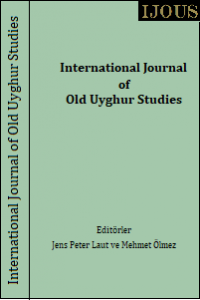Eski Uygur Hukuk Belgelerinde Kısaltmalar
Kısaltmalar, kelime ya da kelime gruplarını yazarken sayfadan yer kazanmak, daha hızlı olmak ya da yazılanın başka kimseler tarafından anlaşılmamasını sağlamak gibi farklı amaçlar için kullanılır. Neredeyse tüm dillerin yazılı ürünlerinde kısaltmalı ifadeler yer almaktadır. Bu çalışma, kısaltmaların Eski Uygur hukuk belgelerindeki varlığını sorgulayarak hangi kelimelerde kısaltma yapıldığını ortaya koymayı amaçlamaktadır. Bu belgelerin seçilmesinin temel sebebi, edebi bir kaygıyla hazırlanmamış olmalarıdır. Çalışmada, öncelikle konuyla ilgili bir açıklama yapılmış, ardından kısaltmaların bulunduğu belgelerden hareketle örnekler verilmiştir.
Anahtar Kelimeler:
Eski Türk Dili, Eski Uygur Türkçesi, hukuk belgeleri, kısaltma
Abbreviations in Old Uighur Legal Documents
Abbreviations are used for different purposes, such as saving space on the page, saving time or ensuring that a text is not understood by someone else. There are abbreviated expressions in the writings of almost all languages. This study mainly investigates the existence of abbreviations in the Old Uighur legal documents and aims to show which words were abbreviated. The main reason why these documents were selected is that they were not prepared with literary concerns. In the study, first of all, the subject had introduced and then examples were given based on the documents.
Keywords:
Old Turkic Old Uighur Turkish, legal documents, abbreviation, shortening,
___
- BAYRAV, S. (1998). Filolojinin Oluşumu. İstanbul: Multilingual.
- CLAUSON, Sir G. (1972). An Etymological Dictionary of Pre-thirteenth Century Turkish. Oxford: Clarendon Press.
- EDZARD, D. O. (2003). Sumerian Grammar. HdO Vol. 71. Leiden-Boston: Brill.
- ELVERSKOG, J. (1997). Uygur Buddhist Literature. Silk Road Studies I. Turnhout: Brepols.
- HERRFAHRDT, H. (1934). “Das Formular der uigurischen Schuldurkunden”, Zeitschrift für Vergleichende Rechtswissenschaft. C. 48. s. 93-103.
- JAGERSMA, A. H. (2010). A Descriptive Grammar of Sumerian. Leiden University Faculty of Humanities. Doktora Tezi. Leiden.
- KAÇALİN, M. S. (2006). Dedem Korkut’un Kazan Bey Oğuz-nâmesi. İstanbul: Kitabevi.
- KALFA, M. (2005). “Dilimizde Kısaltmalar Sorunu”. Türk Dili. C. LXXXIX. Sayı 639. s. 201-207.
- KORKMAZ, F. ve KESKİN B. (2018). “İpek Yolundaki Eski Uygur Ticari İlişkileri”. Uluslararası İpek Yolu Sempozyumu: Türkiye ile Kore Arasında Uygarlıkların Etkileşimi, Bildiriler, 2-3 Temmuz İstanbul 2018. ed. Fikret Turan, Filiz Ferhatoğlu vd. İstanbul: İstanbul Üniversitesi Türkiyat Araştırmaları Enstitüsü. s. 83-96.
- KORKMAZ, Z. (2017). Dil Bilgisi Terimleri Sözlüğü. 5. Baskı. Ankara: TDK Yayınları.
- MALOV, S. (1951). Pamyatniki Drevnetyurkskoy Pismennosti. Moskova-Leningrad: Akademii Nauk.
- MATSUI, D. (2006). “Six Uigur Contracts from the West Uigur Period (10th-12th Centuries)”. Studies in the Humanities (Volume of Cultural Sciences). C. 15 (February 2006). s. 35-60.
- MATSUI, D. (2017). “Uigur and Mongol Inscriptions of the Dunhuang Grottoes”. Multilingual Source Materials of the Dunhuang Grottoes. ed. Dai Matsui, Shintaro Arakawa. Tokyo: Tokyo University Foreign Studies, s. 1-161.
- MORIYASU, T. (2008). “Chronology of West Uighur Buddhism”. Aspects of Research into Central Asian Buddhism. In Memoriam Kōgi Kudara. ed. Peter Zieme. Silk Road Studies 16. Turnhout: Brepols, s. 191-227.
- ODA, J. (1987). “On the Title ‘Tutung’ in Uigur”. Tōyōshi-kenkyū. C. 46-1. s. 57-86.
- RASCHMANN, S.-C. (2007). Alttürkische Handschriften Teil 13, Dokumente Teil 1. Stuttgart: Franz Steiner Verlag.
- RASCHMANN, S.-C. (2015). “Zweihundert kuanpu für ein Kalb. Der Nachlass R. R. Arat in Istanbul”. Opuscula György Hazai Dicata, Beiträge zum Deutsch-Ungarischen Workshop aus Anlass des 80. Geburtstages von György Hazai. ed. Barbara Kellner-Heinkele, Simone-Christiane Raschmann. Berlin: Klaus Schwarz Verlag. s. 210-223.
- TUGUŞEVA, L. Y. (2013). Uygurskie delovye dokumenty X-XIV vv. iz Vostoçnogo Turkestana. Moskova: Nauka.
- VARDAR, B., GÜZ N., HUBER E. vd. (1998). Açıklamalı Dilbilim Terimleri Sözlüğü. 2. Baskı. İstanbul: ABC Kitabevi.
- YAMADA, N. (1993). Sammlung uigurischer Kontrakte II. haz. Juten Oda, Peter Zieme, Hiroshi Umemura, Takao Moriyasu. Osaka: Osaka University Press.
- ZIEME, P. (1981). “Uigurische Steuerbefreiungsurkunden für buddhistische Klöster”. Altorientalische Forschungen. C. 8. s. 237-263.
- ZIEME, P. (1990). “Sur quelques titres et noms des bouddhistes turcs”. L’asie Centrale et ses Voisins: Influences réciproques. ed. Rémy Dor. Paris: Inalco. s. 131-139. ZIEME, P. (2015). “Local Literatures: Uighur”. Brill’s Encyclopedia of Buddhism. Vol. I: Literature and Languages. ed. Jonathan A. Silk. Leiden-Boston: Brill. s. 871-882.
- Yayın Aralığı: Yılda 2 Sayı
- Başlangıç: 2019
- Yayıncı: Mehmet ÖLMEZ
Sayıdaki Diğer Makaleler
Eski Uygurca Din Dışı Belgelerde Geçen bir Moğol Kadın Başlığı
Tonyukuk / Tunyukuk Adı Üzerine
Old Uyghur Documents concerning the Postal System of the Mongol Empire
Eski Türk Yazıtlarında Geçen Yer-Yön Adlarının Sarı Uygurcadaki Durumu
Eski Uygur Türkçesinde Budizm ve Manihaizm Terimleri
Eski Uygur Hukuk Belgelerinde Kısaltmalar
Yuezhi Adının Yeniden Yapılandırılması
2017 Yılında Eski Uygurca Üzerine Yapılan Çalışmalar
